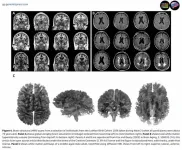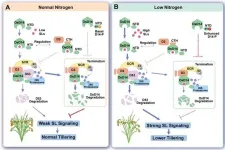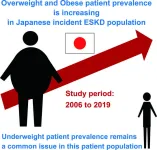(Press-News.org) Philadelphia, November 7, 2024 – Melanoma accounts for only 1% of skin cancers in the United States but results in the largest number of skin cancer deaths. Investigators evaluated the potential link between the availability and use of tanning beds and the rising rates of melanoma in New England. They found compelling evidence linking tanning bed usage to increased melanoma risk. Their spatial epidemiologic study in the Journal of Investigative Dermatology, published by Elsevier, provides critical insights to inform public health strategies and reduce melanoma incidence.
The incidence of melanoma in the US has been increasing over the past two decades. Melanoma incidence continues to increase at about 1% each year among females, while it has stabilized in men. Many factors contribute to a region’s incidence of melanoma; the most preventable risk factor is ultraviolet (UV) radiation from both natural sources like solar radiation and artificial sources like tanning beds.
Lead investigator Oliver Wisco, DO, Associate Professor of Dermatology, Warren Alpert Medical School of Brown University and co-first authors Megan M. Tran, Department of Dermatology, Warren Alpert Medical School of Brown University, and Guixing Wei, PhD, Spatial Structures in the Social Sciences, Population Studies and Training Center, Brown University, explain, “Our patients are our primary source of inspiration for this research. Every day, we encounter patients diagnosed with melanoma. Witnessing the devastating impact of this disease drives us to find ways to prevent it. Despite the well-known dangers of UV radiation, access to tanning beds remains widespread, and their usage continues to be prevalent in many regions. This reality compelled us to investigate the potential link between the availability and use of these facilities and the rising rates of melanoma. Our goal was to better understand whether areas with greater access to tanning beds also experience higher rates of melanoma, with the hope that this knowledge could inform more effective public health strategies to combat skin cancer.”
Investigators evaluated the geospatial relationship between melanoma incidence and access to tanning bed facilities at the county level in New England (2014-2018). They obtained melanoma incidence rates, tanning bed facilities locations, and demographic, socioeconomic, and geographic data from the National Cancer Institute State Cancer Profiles, Data Axle, American Community Survey, and United States Geological Survey.
The study revealed a significant association between greater access to tanning bed facilities and increased rates of melanoma in the New England region of the US. Investigators identified six high-risk clusters, seven low-risk clusters, and one outlier of melanoma incidence. Adjusted spatial regression identified that for every one-minute increase in average travel time to tanning facilities within a 30-minute travel time threshold, the melanoma incidence rate decreased by 3.46% in the same county and 1.92% across New England. These results suggest that people in regions with more tanning bed facilities may experience higher incidences of melanoma.
Dr. Wisco notes, “Although we anticipated finding a connection between tanning beds and melanoma, the strength of the association was more pronounced than expected. Our findings add to the growing body of evidence linking tanning bed usage to increased melanoma risk. These results provide critical insights to inform public health strategies aimed at reducing tanning bed use and ultimately, melanoma incidence. We hope to empower individuals to make informed decisions about their skin health and protect themselves from this disease.”
The research team concludes, “Despite growing awareness of skin cancer risks, melanoma continues to be a major public health concern. Our research offers compelling geographic evidence linking access to tanning beds to this deadly disease. The negative association between travel time to tanning facilities and county-level melanoma incidence rate suggests that decreasing access to indoor tanning facilities may help reduce the regional melanoma incidence rate. Future registries should consider capturing data on tanning bed usage to help refine and target melanoma prevention efforts. However, additional research with detailed tanning behavioral data is needed.”
Commenting on the study, noted expert David E. Fisher, MD, PhD, Massachusetts General Hospital (MGH), Harvard Medical School, and Director of the Melanoma Program, MGH Cancer Center and Cutaneous Biology Research Center, MGH, adds: “Melanoma is one of the relatively few human cancers for which a common, preventable cause is well documented: UV radiation. This study helps clarify the linkage between tanning beds and melanoma and helps us focus on how policies aimed at limiting tanning bed use may hopefully further diminish melanoma risk.”
END
Tanning bed access and usage is driving higher rates of melanoma in specific regions
A geospatial analysis found compelling evidence that areas with more tanning bed facilities tend to experience higher rates of melanoma, reports the Journal of Investigative Dermatology
2024-11-07
ELSE PRESS RELEASES FROM THIS DATE:
Mitochondrial dysfunction research transforms mental health: Dr. Ana Andreazza's vision
2024-11-07
Toronto, Canada, 7 November 2024 – From a curious young scientist investigating her grandfather's family wine to a leading expert in mitochondrial health and mental illness, Dr. Ana Cristina Andreazza's journey exemplifies the power of personal motivation in driving scientific innovation. As founder and Scientific Director of the Mitochondrial Innovation Initiative (Mito2i), Dr. Andreazza is revolutionizing our understanding of the connection between cellular energy production and mental health.
In an illuminating Genomic Press Interview, published in Brain Medicine on November 7, 2024, ...
Dr. Nora Volkow shares insights on addiction science and harm reduction in Genomic Press interview
2024-11-07
Bethesda, Maryland, USA, 7 November 2024 – Dr. Nora Volkow's mission to revolutionize addiction treatment began with a deeply personal observation: watching how excessive substance use could profoundly alter a person’s behavior while simultaneously triggering social rejection by others. As the first woman and Hispanic Director of the National Institutes of Health’s National Institute on Drug Abuse (NIDA), Dr. Volkow has dedicated her career to investigating how drugs affect the human brain and how these disruptions contribute to the behavioral/emotional ...
25-year study reveals key factors in healthy brain aging and cognitive performance
2024-11-07
Edinburgh, Scotland, 7 November 2024 – A groundbreaking 25-year research program has unveiled key insights into how our brains age and what factors influence cognitive performance throughout life. The findings, published on 7 November 2024 in Genomic Psychiatry, draw from the Lothian Birth Cohorts (LBC) studies, which uniquely tracked participants' cognitive abilities from childhood through their eighth decade of life.
Professor Ian Deary and Dr. Simon Cox from the University of Edinburgh present remarkable discoveries that challenge conventional wisdom about brain aging. Their research ...
First clinical trial reveals promise of psilocybin treatment for anorexia nervosa
2024-11-07
San Diego, California, 7 November 2024 – In a groundbreaking exploration of psychedelic medicine's potential for treating one of psychiatry's most challenging conditions, researchers at University of California, San Diego (UCSD) provided an analysis and further details of a trial published in Nature Medicine (https://pmc.ncbi.nlm.nih.gov/articles/PMC10427429/) that had shown how psilocybin therapy affects individuals with anorexia nervosa. In the new peer-reviewed Emerging Topic article in Psychedelics ...
Fabrication of 4-inch wafer-scale heterostructure via PECVD drives AI semiconductor performance innovation!
2024-11-07
As artificial intelligence (AI) technology advances, the demand for higher-performing semiconductors is rapidly growing. The development of new materials and innovative structures to achieve high-performance semiconductors has become crucial. For the first time globally, a 4-inch heterostructure fabrication technology using plasma-enhanced chemical vapor deposition (PECVD) has been developed. This breakthrough enables the production of low-power, high-performance semiconductors, surpassing the capabilities of traditional silicon-based technology.
The research team led by Senior Researcher Hyeong-U Kim of the Semiconductor Manufacturing Research Center of the ...
Plastic device aids robot-assisted heart surgery
2024-11-07
Robot-assisted heart surgery usually requires an assistant at the operating table to help the surgeon insert the robot arm through a small incision. The assistant has to constantly make sure the surgeon has enough room to operate via the robot arm. For greater independence on the surgeon’s side, an Osaka Metropolitan University-led group has developed a device that can secure the surgical field.
Graduate School of Medicine Professor Toshihiko Shibata and Associate Professor Yosuke Takahashi worked with colleagues and small and ...
UVM scientists find space-for-time substitutions exaggerate urban bird–habitat ecological relationships
2024-11-07
As bird populations dwindle across the globe, a new study from University of Vermont researchers suggests some species may be more flexible to habitat changes than previously understood, creating new opportunities for supporting populations through city planting efforts. The team’s findings were published in the Journal of Animal Ecology today.
While studies have found bird populations are on the decline—Canada and the United States have lost nearly three billion birds over the last half century—measuring ...
Molecular Frontiers Symposium in Hong Kong “Frontiers of New Knowledge in Science”
2024-11-07
Event Date: 15 November 2024 to 17 November 2024
Time: 9:00am - 6:30pm
Venue: Main Hall, Shaw Auditorium, HKUST
INTRODUCTION
The Molecular Frontiers Symposium, organized by the globally renowned Molecular Frontiers Foundation - founded by the Royal Swedish Academy of Sciences - is recognized as one of the most influential scientific organizations worldwide.
For the first time in the organization’s history, the Foundation's annual flagship symposium will be held in Greater China, hosted at The Hong Kong University of Science and Technology.
With the theme "Frontiers of New Knowledge in Science", the Symposium ...
Scientists reveal strigolactone perception mechanism and role in tillering responses to nitrogen
2024-11-07
“How is plant growth controlled?” and “What is the basis of variation in stress tolerance in plants?” were among the 125 most challenging scientific questions, according to the journal Science in 2016.
Strigolactone (SL) is an important plant hormone that plays essential roles in regulating branch number, a key growth and development trait for plants. Recently, scientists from the Chinese Academy of Sciences (CAS) have uncovered the mechanism behind SL perception and its key role in the tillering response to nitrogen.
The “gas and brake” mechanism of SL perception allows “smart and flexible” regulation of the duration ...
Increasing trend of overweight and obesity among Japanese patients with incident end-stage kidney disease
2024-11-07
Niigata, Japan - A new nationwide study from Japan spanning a 14 year study period has revealed an increasing trend of overweight and obesity in patients with the incident end-stage kidney disease (ESKD). Although, underweight individuals remain prevalent in this patient population, the study highlights that excessive weight and obesity in patients with the incident ESKD is a shared global challenge. Consequently, the study suggests the need for public health strategies to address the global obesity epidemic as well as underweight individuals in incident ESKD populations.
“The global ...
LAST 30 PRESS RELEASES:
An ‘illuminating’ design sheds light on cholesterol
Who is more likely to get long COVID?
Study showcases resilience and rapid growth of “living rocks”
Naval Research Lab diver earns Office of Naval Research 2025 Sailor of the Year
New Mayo-led study establishes practical definition for rapidly progressive dementia
Fossil fuel industry’s “climate false solutions” reinforce its power and aggravate environmental injustice
Researchers reveal bias in a widely used measure of algorithm performance
Alcohol causes cancer. A study from IOCB Prague confirms damage to DNA and shows how cells defend against it
Hidden viruses in wastewater treatment may shape public health risks, study finds
Unlock the power of nature: how biomass can transform climate mitigation
Biochar reshapes hidden soil microbes that capture carbon dioxide in farmland
Reducing saturated fat intake shows mortality benefit, but only in high-risk individuals
Manta rays create mobile ecosystems, study finds
Study: Mixed results in using lipoic acid to treat progressive multiple sclerosis
Norbert Holtkamp appointed director of Fermi National Accelerator Laboratory
New agentic AI platform accelerates advanced optics design
Biologists discover neurons use physical signals — not electricity — to stabilize communication
Researchers discover that a hormone can access the brain by hitchhiking
University of Oklahoma researcher awarded funding to pursue AI-powered material design
Exploring how the visual system recovers following injury
Support for parents with infants at pediatric check-ups leads to better reading and math skills in elementary school
Kids’ behavioral health is a growing share of family health costs
Day & night: Cancer disrupts the brain’s natural rhythm
COVID-19 vaccination significantly reduces risk to pregnant women and baby
The role of vaccination in maternal and perinatal outcomes associated with COVID-19 in pregnancy
Mayo Clinic smartwatch system helps parents shorten and defuse children's severe tantrums early
Behavioral health spending spikes to 40% of all children’s health expenditures, nearly doubling in a decade
Digital cognitive behavioral treatment for generalized anxiety disorder
Expenditures for pediatric behavioral health care over time and estimated family financial burden
Air conditioning in nursing homes and mortality during extreme heat
[Press-News.org] Tanning bed access and usage is driving higher rates of melanoma in specific regionsA geospatial analysis found compelling evidence that areas with more tanning bed facilities tend to experience higher rates of melanoma, reports the Journal of Investigative Dermatology









